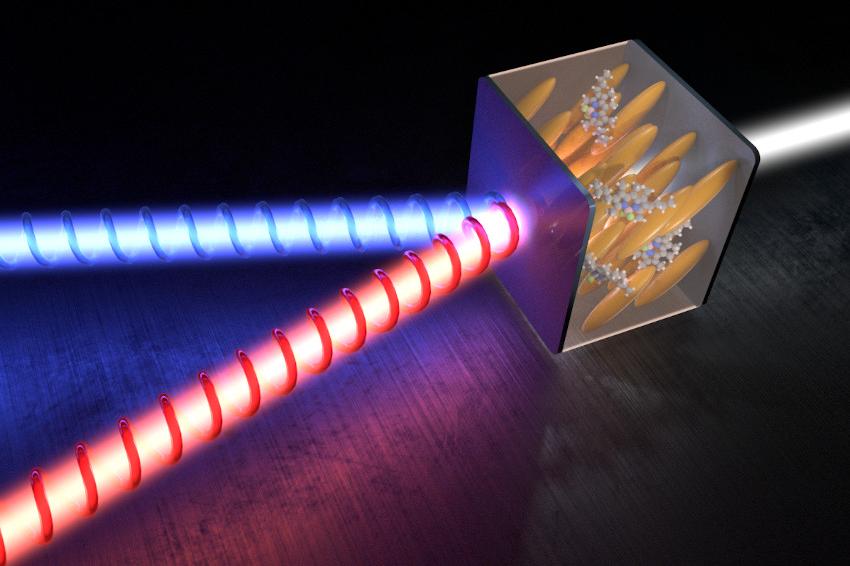Tiny microlaser emits two circular beams
A microcavity was filled with a liquid crystal doped with an organic laser dye
Scientists from the University of Warsaw, the Military University of Technology and the University of Southampton presented a new type of tunable microlaser emitting two beams. These beams are polarized circularly and directed at different angles. This achievement was obtained by creating a persistent-spin helix on the surface of the microcavity.
To achieve this effect, scientists around Jacek Szczytko from the faculty of physics filled the optical microcavity with a liquid crystal doped with an organic laser dye. The microcavity consists of two perfect mirrors placed close to each other at a distance of 2-3 microns, so that a standing electromagnetic wave is formed inside. The space between the mirrors was filled with a special optical medium – liquid crystal, which was additionally organized using a special mirror coating. The characteristic feature of liquid crystals are their elongated molecules and, figuratively speaking, they were combed on the surface of the mirrors and could stand up under the influence of an external electric field, turning also other molecules filling the cavity.
The light in the cavity interacts with the molecules in a different way, when the electric field of the propagating wave oscillates along the molecules and differently, when oscillation are perpendicular to them. The liquid crystal is a birefringent medium – it can be characterized by two refractive indexes, which depend on the direction of the electric field oscillations, i.e. the electromagnetic wave polarization. The precise arrangement of molecules inside the laser microcavity, obtained at the Military University of Technology resulted in the appearance of two linearly polarized light modes in the cavity i.e. two standing waves of light with opposite linear polarizations. The electric field changed the orientation of the molecules inside the optical cavity, which changed the effective refractive index of the liquid crystal layers. Thus it controlled the length of the optical path of light – the product of the width of the cavity and the refractive index on which the energy of the emitted light depends. One of the modes did not change its energy as the molecules rotated, while the energy of the other increased as the orientation of the molecules changed.
By stimulating optically the organic dye placed between the molecules of the liquid crystal, lasing effect was obtained. The gradual rotation of the liquid crystal molecules leaded to unexpected properties of this lasing. The lasing was achieved for this tunable mode: the laser emitted one linearly polarized beam perpendicular to the surface of the mirrors. The use of liquid crystals allowed for a smooth tuning of the light wavelength with the electric field by as much as 40 nanometer. “However, when we rotated the liquid crystal molecules so that both energy of modes – the one sensitive to the orientation of the molecules and the one that did not change its energy – overlapped, the light emitted from the cavity suddenly changed its polarization from linear to two circular: right - and left-handed, with both circular polarities propagating in different directions, at an angle of several degrees”, says Jacek Szczytko.
The phase coherence of the laser has been confirmed in an interesting way. “The persistent-spin helix –pattern of stripes with different polarization of light, spaced 3 microns apart – appeared on the surface of the sample. Theoretical calculations show that such a pattern can be formed when two oppositely polarized beams are phase coherent and both modes of light are inseparable. This phenomenon is compared to quantum entanglement”, says Marcin Muszynski.
So far, the laser works in pulses, because the organic dye that was used slowly photodegrades under the influence of intensive light. Scientists hope that replacing the organic emitter with more durable polymers or inorganic materials (e.g. perovskites) will allow for longer lifetime. “The obtained precisely tunable laser can be used in many fields of physics, chemistry, medicine and communication. We use nonlinear phenomena to create a fully optical neuromorphic network. This new photonic architecture can provide a powerful machine learning tool for solving complex classification and inference problems, and for processing large amounts of information with increasing speed and energy efficiency”, says Barbara Pietka from the faculty of physics. (Source: U Warsaw)







